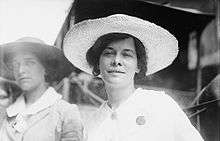Elisabeth Freeman
| Elisabeth Freeman | |
|---|---|
 | |
| Born |
September 12, 1876 England |
| Died | February 27, 1945 (aged 68) |
| Nationality | American |
| Known for | suffragist |
Elisabeth Freeman (September 12, 1876 – February 27, 1942) was a suffragist and civil rights activist, best known for a report for the NAACP on the lynching of Jesse Washington[1] and for her participation in the 1913 Suffrage Hike from New York City to Washington, D.C.
Biography
Elisabeth Freeman[2] was born in England in 1876 to Mary Hall Freeman, who was estranged from her husband. She was the younger sister of artist Jane Freeman.[3] Elisabeth, her mother, and two siblings moved to the United States, where they lived on Long Island, New York. Mary worked for an orphanage, and the children lived there for a while.
Growing up poor, Elisabeth Freeman did not get a college education and was reported to have found only her activities for the Salvation Army "uplifting".[4] After moving back to London, she helped a woman who was beaten by a policeman and both she and the woman were arrested. The woman brought her into the suffrage movement,[4] within which she learned the arts of campaigning, including public speaking, media work and recruitment. Having developed such skills in London, she then brought them back to the US, where she was employed by the suffrage movement.[4]
_d6db2bf1ce_o.jpg)
One notable example of her activism occurred in 1913, when she took part in the national Suffrage Hike to the inauguration of Woodrow Wilson in Washington, D.C.[1] As a publicity stunt in New York City she wore a gypsy costume and drove a wagon stenciled with 'Votes for Women' slogans and piled with women's suffrage literature.[5]
On May 16 1916, while working for the suffrage movement in Texas, she was asked by the NAACP to investigate the lynching of Jesse Washington.[6] For a week, she talked to people in Waco, and her documentation of the lynching to W. E. B. Du Bois was the base for garnering national attention.

In the years between 1917 and 1919, she was active for the peace movement, where she lobbied Congress and continued her work fighting for the cause of civil rights, although speaking up against US policies concerning the war garnered strong reactions.
Freeman owned an antique store in Provincetown, Massachusetts from 1925 until 1937, when she moved to Pasadena, California for health reasons.[4] She died of pleurisy in February 1942.[1]
See also
References
| Wikimedia Commons has media related to Elizabeth Freeman. |
- 1 2 3 "Elisabeth Freeman". Retrieved 2008-12-15.
Elisabeth Freeman came to this country as a small child with her brother John and sister (Clara) Jane, and their mother, Mary Hall Freeman, who came estranged from her husband. Mary worked for St. Johnland, an orphanage on Long Island for a time, and the children lived at the orphanage for some time. ...
- ↑ Bernstein, Patricia (2006). The First Waco Horror: The Lynching of Jesse Washington and the Rise of the NAACP. College Station: Texas A&M University Press. p. 64. ISBN 978-1-58544-544-8.
- ↑ "Jane Freeman Is Dead at 92; Portraitist Painted Schweitzer". The New York Times. September 23, 1963. Retrieved June 19, 2017.
- 1 2 3 4 "An Interactive Scrapbook of Elisabeth Freeman: Suffragette, Civil Rights Worker, and Militant Pacifist.".
- ↑ "Marching for the Vote". Library of Congress. Retrieved 2008-12-15.
One of the New York group, Elisabeth Freeman, dressed as a gypsy and drove a yellow, horse-drawn wagon decorated with Votes for Women symbols and filled with pro-suffrage literature, a sure way to attract publicity.
- ↑ Wade Goodwyn (May 13, 2006). "Waco Recalls a 90-Year-Old 'Horror'". National Public Radio. Retrieved 2010-09-08.
On May 16, 1916, one day after the lynching of Jesse Washington, Royal Freeman Nash, the white social worker who was then secretary of the NAACP, wired Elisabeth Freeman in Fort Worth, where she remained following the statewide suffrage convention in Dallas.